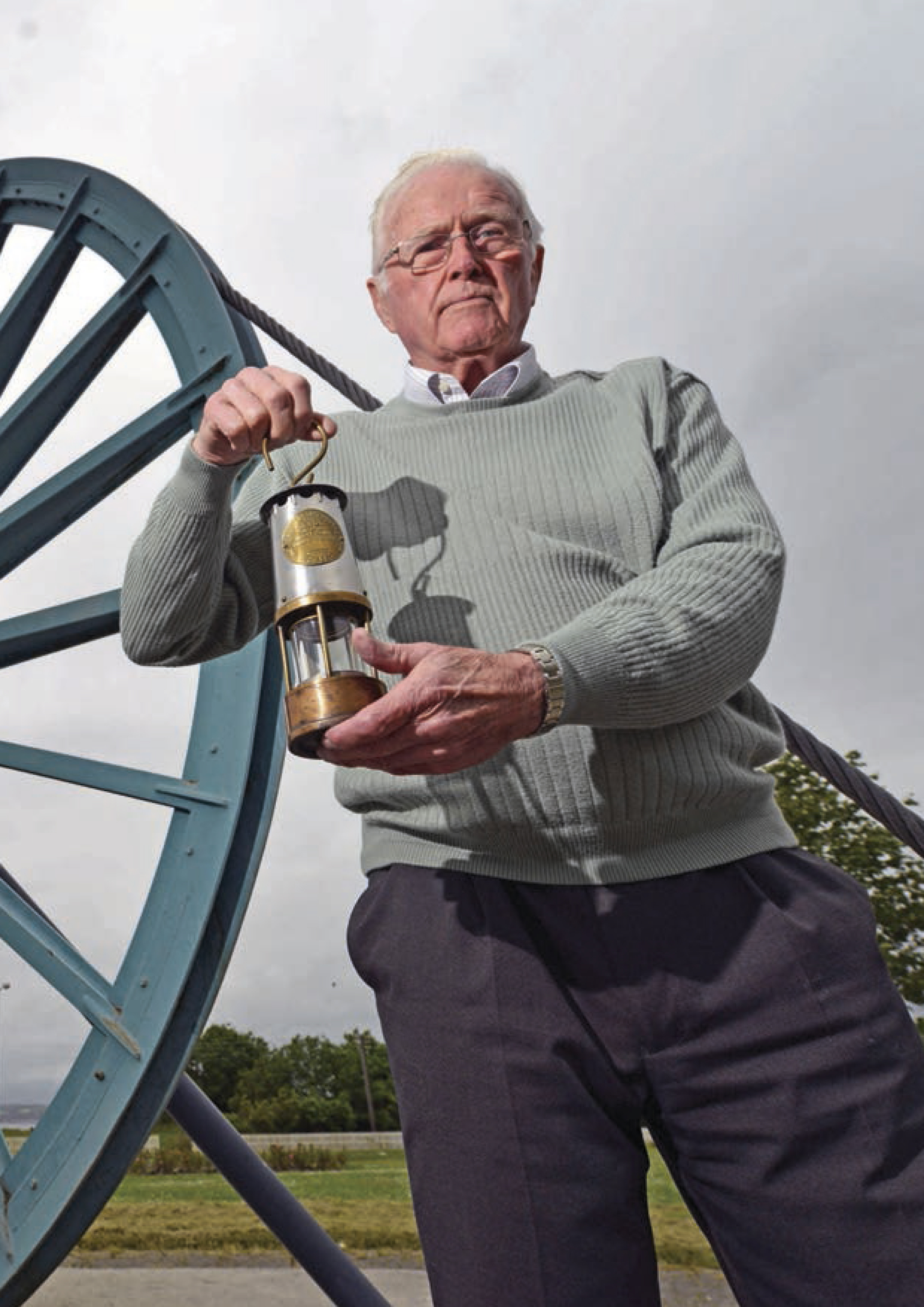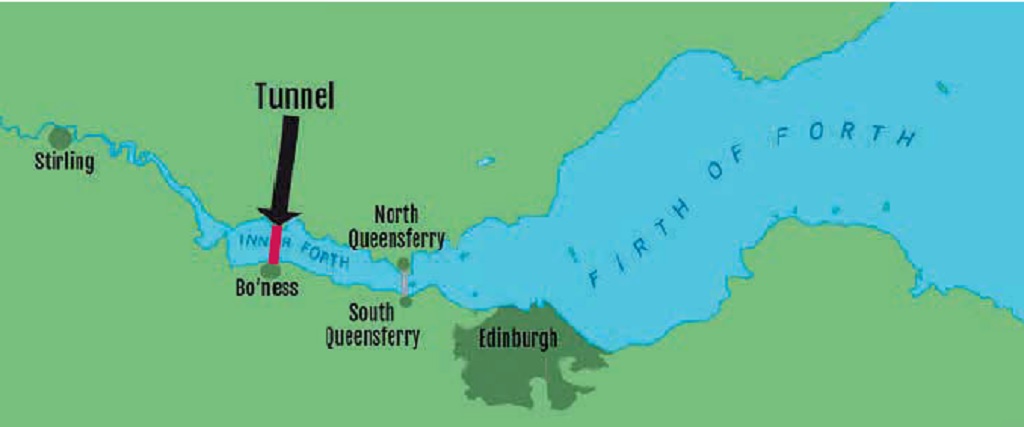
The forgotten tunnel that crosses the River Forth
With three famous bridges now crossing the Forth of the Forth, a forgotten passage that once connected the Lothians and Fife lies dormant and flooded 2,000 feet below the estuary.
A remarkable feat of engineering, the 15ft by 10ft winding tunnel was ground out of rock in the early 1960s by miners working against the clock to save the threatened Valleyfield Colliery in Fife.
For the first time in history, four months before the much-celebrated Forth Road Bridge was officially opened, it was possible to walk directly from the Lothians to Fife through five hot, dark kilometres deep underground.
Mine surveyor Alistair Moore was the man tasked with engineering the ambitious passageway. Now 84 and living in Bo’ness, just a stone’s throw from the site he was sent to more than 50 years ago, he explains: ‘I was working at Wesley Colliery in Fife when I got a phone call from the area office saying they wanted to see me. They told me that on Monday morning I was to report to Kinneil Colliery on the other side of the Forth.
‘I went there and introduced myself to the manager, Mr Archibald. He told me they were proposing to connect Kinneil Colliery with Valleyfield on the other side of the river, and I’d been nominated to come and do the job!’
The Valleyfield Coal Preparation Plant had been condemned by the Mines Inspectorate and with just six months to find an alternative, the colliery was facing closure. ‘The preparation plant at Valleyfield was the nub of the thing,’ Alistair says. ‘The idea was to connect Valleyfield with Kinneil because the preparation plant there was relatively new and had all the mod cons available at the time.’
And so began a series of complex plans and calculations. With limited time, two teams of six men were to dig through the rock from both sides of the Forth and meet in the middle. But it wasn’t as simple as carving out a straight line – the coal seams and sandstone layers, thrown into disarray thousands of years earlier by the Cockleroy volcano near Linlithgow – dictated a convoluted route of slopes and angles, with one team tunnelling through coal while the other worked through rock beneath it.
‘The Cockleroy has a lot to answer for,’ laughs Alistair, who used ordinance survey coordinates and piano wire-measurements to ensure that the direction and, more complex still, the levels from each side were perfectly aligned. ‘If I put a foot wrong they could have gone right past each other. ’

Mine surveyor Alistair Moore
As the two teams inched closer together, Alistair had another reason to speed up the work. ‘I had arranged my holidays to go up to Aberdeenshire where my wife came from, so I was desperate to get it through,’ he admits.
With an estimated 25ft of rock left separating the two teams, Alistair spent the weekend he was due to go away ‘scrounging’ five foot boring rod extensions from nearby collieries to assess exactly how close the connection was.
On the Monday morning he made his way down the tunnel from Kinneil and watched as rod after rod punched through the rock. Conversation was impossible because of the noise of the drills, but with the end in sight Alistair stuck around. Suddenly, sometime around mid-morning, the rod met no resistance and the machines stilled.
‘The boys got the drills out and there was a three and a half inch hole,’ he says. ‘I shouted “hello?”, then put my ear to the hole and an echoing “hello” came back.’
With the all-important levels at the forefront of his mind, Alistair asked where the hole was in relation to the passage floor. The reply, 3ft 4inches, was just three inches short of the Kinneil side. ‘I would have liked it to be right on, but three inches wasn’t bad,’ he laughs.
After reporting back that the connection had been made, Alistair left for his holiday, leaving his managers and union officials to grin for the cameras at the formal breakthrough on 30 April 1964. Kinneil miner Martin ‘Tiger’ Shaw and Andrew Drysdale from Valleyfield ceremoniously broke away the last bit of rock and the extraordinary tunnel was officially complete.
The headline in Coal News declared ‘River tunnel links 2 pits’, while a piece in the Edinburgh Evening News reported: ‘The drill in the hands of Tiger Shaw began biting through the thin sandstone shell, the last barrier in the tunnel link, at 10.30am. Three minutes later, the lamps of the Valleyfield squad blinked through the gap in the rock and Shaw and Drysdale were face to face.’

The tunnel lies abandoned beneath the waves
The understated celebration was in stark contrast to the one that took place above ground on 4 September, when 50,000 people turned out to witness the Queen and the Duke of Edinburgh officially open the Forth Road Bridge.
Hard working yet understated, that was the miners’ way. It was exemplified by Alistair Moore, whose modest account of successfully engineering such a complex passage – at a total cost of just £500,000 – belies just how ground-breaking an achievement it really was.
Valleyfield remained operational for another 14 years, with the coal transported underground and processed at Kinneil until its closure in 1978. The Coal Board had intended the tunnel give Kinneil another century of working life, but difficult geology coupled with the outcome of the 1979 General Election meant Kinneil acrimoniously closed at the end of 1982.
Today the tunnel, which for two decades allowed people to walk shore to shore under the Forth, is largely forgotten, with many outside of the mining community unaware it ever existed.
Despite the immense effort he ploughed into its creation, Alistair remains matter of fact about the tunnel’s demise.
‘The mines might be there because they were in solid rock, but the steel work will have rusted and the place will be full of water now,’ he says. ‘Still,’ he adds smiling, ‘I can boast that I am the only person that had their breakfast in Bo’ness, their lunch in the canteen at Valleyfield, and afternoon tea in the canteen at Bo’ness, and I walked all the way!’
(This feature was originally published in 2015)
TAGS

